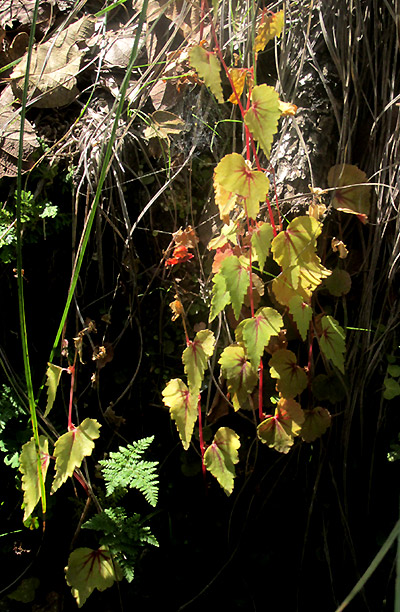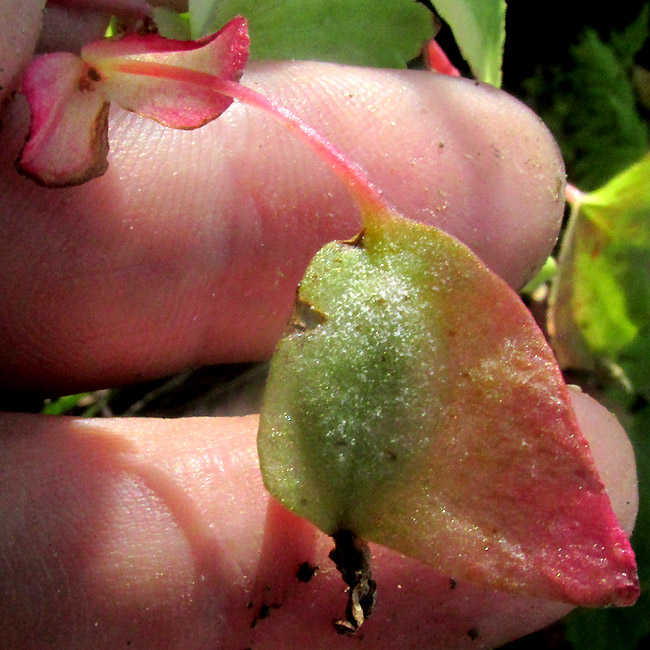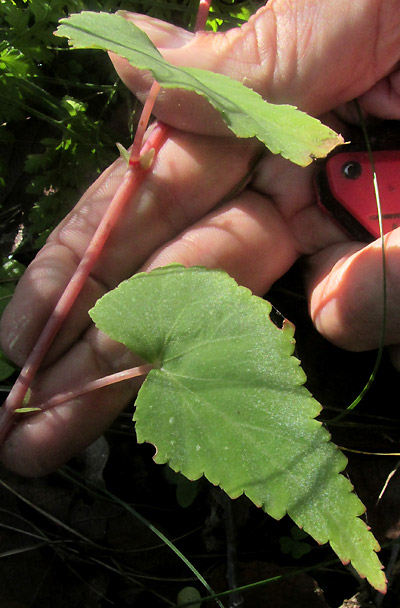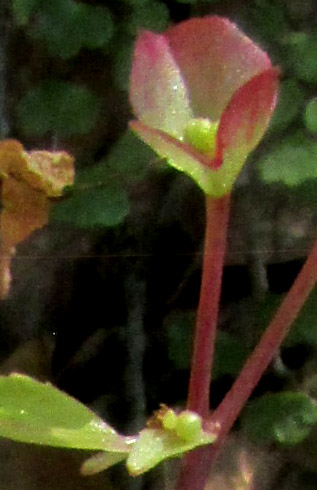Excerpts from Jim Conrad's
Naturalist Newsletter
from the September 7, 2007 Newsletter issued from Sierra Gorda Biosphere Reserve, QUERÉTARO, MÉXICO
HOLLYHOCK BEGONIA FLOWERING
 We have wild begonias here. Last Saturday I hitched a ride with Pancho, who was carrying supplies to ladies in a highland village whose sewing cooperative is being helped by the reserve. Leaving Jalpan we saw that surrounding mountaintops were all chopped off by clouds. Along muddy, gravel-and-dirt roads we bounced and slid into those clouds and when we got to the ridge top and I left the truck the cloud-fog was so dense we could see only a few truck-lengths away. It was drizzling and 63°. During the rest of the day I hiked back into the lowlands just for the pure pleasure of seeing the roadside flora up close, and of descending through clouds into a lush, vibrantly green valley through which a little stream roared carrying white water.
We have wild begonias here. Last Saturday I hitched a ride with Pancho, who was carrying supplies to ladies in a highland village whose sewing cooperative is being helped by the reserve. Leaving Jalpan we saw that surrounding mountaintops were all chopped off by clouds. Along muddy, gravel-and-dirt roads we bounced and slid into those clouds and when we got to the ridge top and I left the truck the cloud-fog was so dense we could see only a few truck-lengths away. It was drizzling and 63°. During the rest of the day I hiked back into the lowlands just for the pure pleasure of seeing the roadside flora up close, and of descending through clouds into a lush, vibrantly green valley through which a little stream roared carrying white water.
I hadn't walked half a mile before finding my first wild begonia, a small, slender one with big flowers, shown in the picture.
Apparently it's too dry in the valley for begonias, for I've not seen them there. Begonias like moisture, and up on that ridge among the clouds begonias have their moisture. Eight begonia species are listed for the Reserve. On the Internet I find descriptions and photos of seven of those eight but the one in my picture isn't any of those.
Entry dated November 7, 2023, from notes taken at Cascadas de La Piedad waterfall 3kms NW of the community of San Pablo, municipality of Almeaco de Bonfil; bedrock of thick layers of compacted volcanic ash, or tuff; N20.1024°, W100.0019°, elevation 2360 meters (7750ft); extreme southern Querétaro state, MÉXICO
HOLLYHOCK BEGONIA IN FRUIT

In a usually shaded spot of a hillside oak forest the above begonia rooted beneath an overhanging washout in an erosional gully, basking in noonday sunlight. When I earlier met this species {above entry} it was flowering, so now it was like meeting an old friend who'd changed with age.

Above you see the somewhat triangular, capsular-type fruit, its pink "wing" eventually encouraging wind dissemination. The dark brown, dried-up item on the fruit, at the picture's bottom is the remains of the flower's stigmas. Begonia flowers are unisexual. Some Begonia species segregate the sexes on different plants, but Begonia gracilis bears both male and female flowers on the same plants. The winged capsule dangles on a slender pedicel issuing from between two large, oval bracts, which are modified leaves.

The shape of the leaves, seen at the right, gives Begonia gracilis its Spanish name, ala de ángel, or "angel wing." However, that name is used for many species, plus in English often the name is reserved for certain ornamental hybrids, or other better known species. With over 1800 species and hybrids, Begonia is the fifth largest genus of flowering plants, and many of those species are called "angel wings." Notice that at the petioles' bases narrow but conspicuous stipules develop.

At the top of the picture shown at the left you see two floral bracts atop a peduncle. I'm unsure what the spherical items are between the bracts, though they are similar to what's produced at the peduncle's base, in a leaf axil. Those are bulbils, among gardeners often known as tubers. They provide asexual reproduction, and as such can be sowed to produce new plants, which will be genetically identical to the parent. In 2012 when begonia grower Doug Hahn identified our plant as a tuberous species, I assumed he was referring to underground tubers, like little potatoes. However, tubers are specialized storage stems, and sometimes tubers grow aboveground, where leaves connect with their stem, as in the picture. Since the two bracts at the picture's top are modified leaves, maybe the green items really are bulbils.
Begonia gracilis occurs in many moist, upland habitats, from oak/pine forests to disturbed areas, from northern Mexico south to Oaxaca, and possibly in Guatemala.
The 2018 work by A. Chavarría and G. Espinoza entitled "Cruz-Badiano Codex and the Importance of the Mexican Medicinal Plants," reports that the Cruz-Badiano Codex, or Libellus de Medicinalibus Indorum Herbis, compiled by an Aztec speaker of Nahuatl in the 1500s, indicates that juice from Begonia gracilis was used to treat baldness and dandruff, and that the Biblioteca Digital Medicina Tradicional Mexicana says it currently is employed as a purgative.
This is yet another species introduced to science by Humboldt and Bonpland, who in 1803 collected it in a forest near Pátzcuaro, Michoacán -- "Crescit in sylvis prope Pazcuaro Mexicanorum," as their notes say.